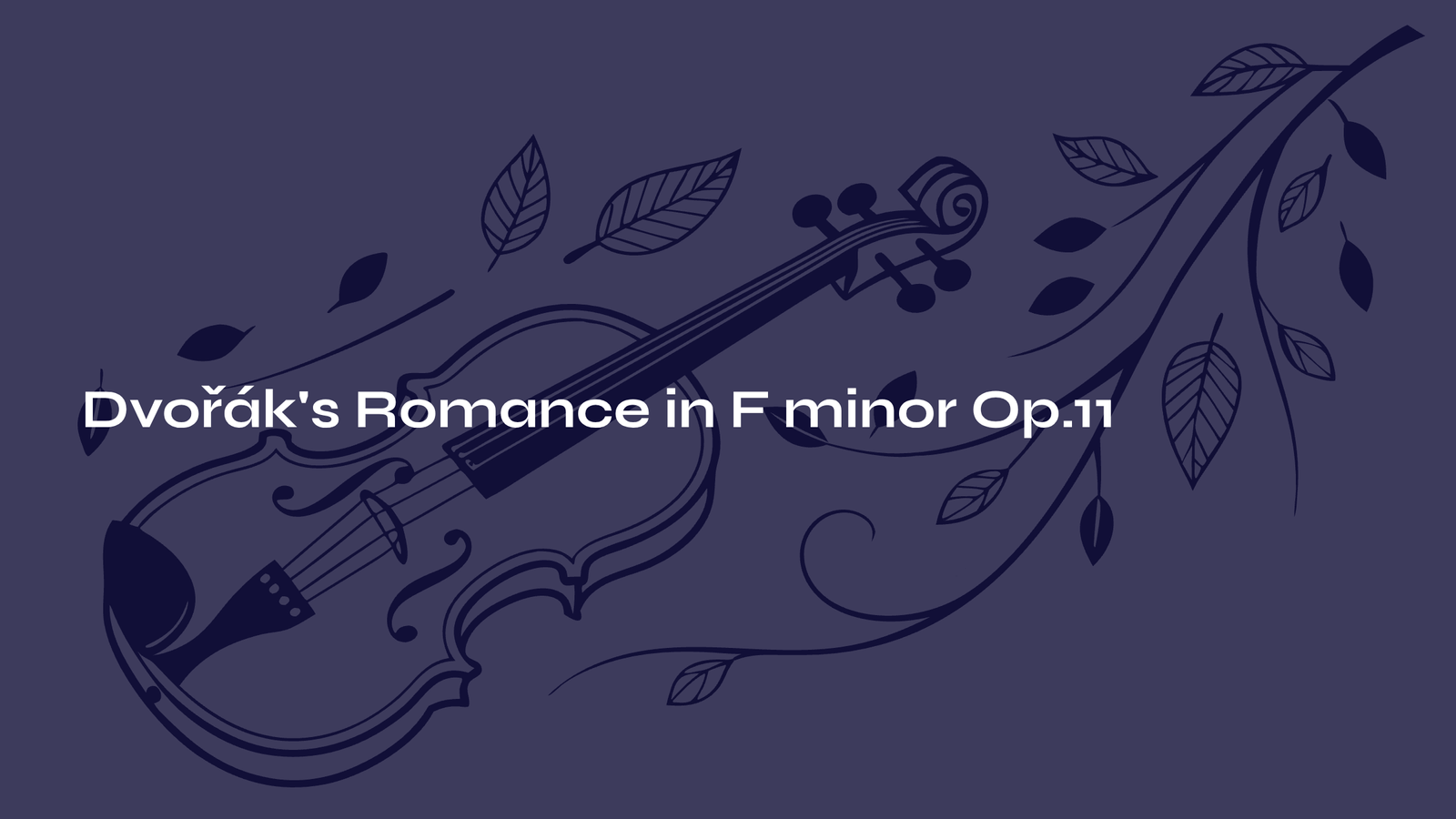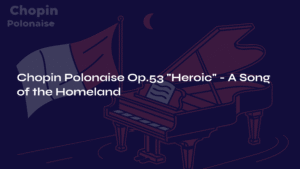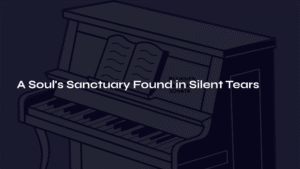Table of Contents
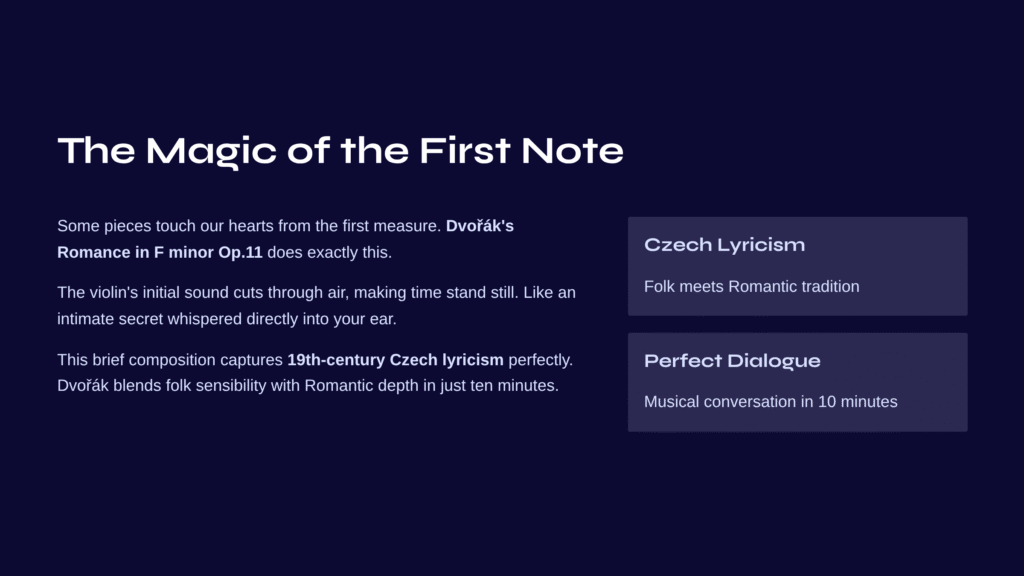
The Magic of the First Note
Some pieces of music touch the deepest corners of our hearts from the very first measure. Dvořák’s Romance in F minor Op.11 is precisely such a work. The moment the violin’s strings tremble and produce that initial sound, cutting through the air, time seems to stand still. It’s as if someone is whispering an intimate secret directly into your ear.
Within this brief composition lies the essence of 19th-century Czech lyricism. Dvořák’s distinctive blend of folk sensibility and Romantic profundity creates a perfect musical dialogue in just over ten minutes. Rather than showcasing virtuosic display, the violin approaches us like an old friend, ready to tell us a story.
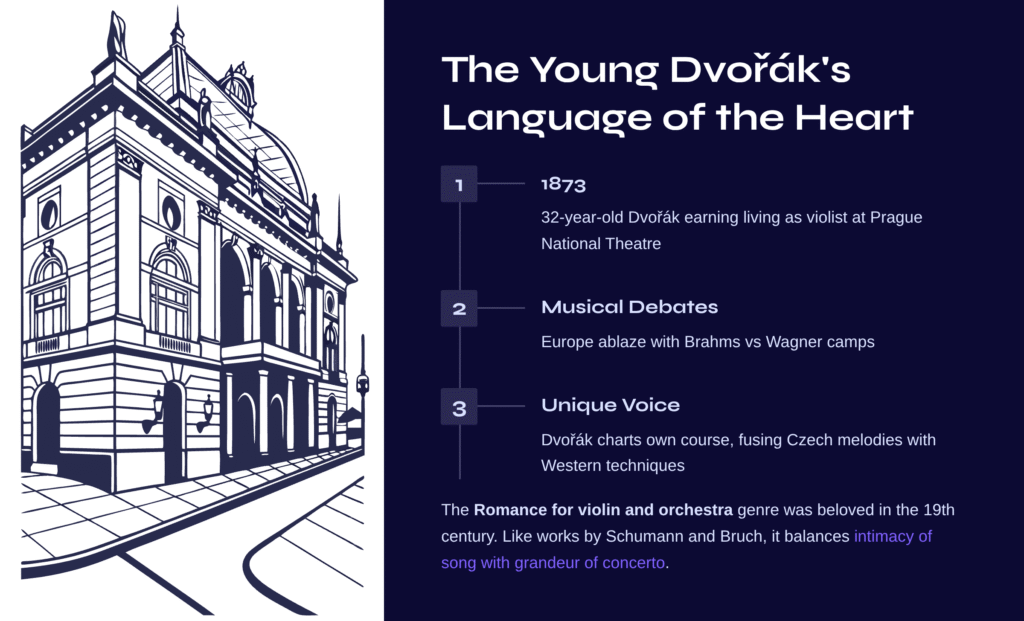
The Young Dvořák’s Language of the Heart
In 1873, the 32-year-old Antonín Dvořák had yet to achieve international recognition. While earning his living as a violist at the Prague National Theatre, he was already developing his unique musical voice. Romance in F minor Op.11 emerged during this transitional period in his career.
Europe at the time was ablaze with the musical debates between Brahms and Wagner camps. Yet Dvořák charted his own course, masterfully fusing Czech traditional melodies with Western Romantic techniques. This Romance clearly demonstrates his distinctive approach.
The genre of Romance for violin and orchestra was particularly beloved in the 19th century. Like the famous works by Schumann and Bruch, it occupies that sweet spot between the intimacy of a song and the grandeur of a concerto.
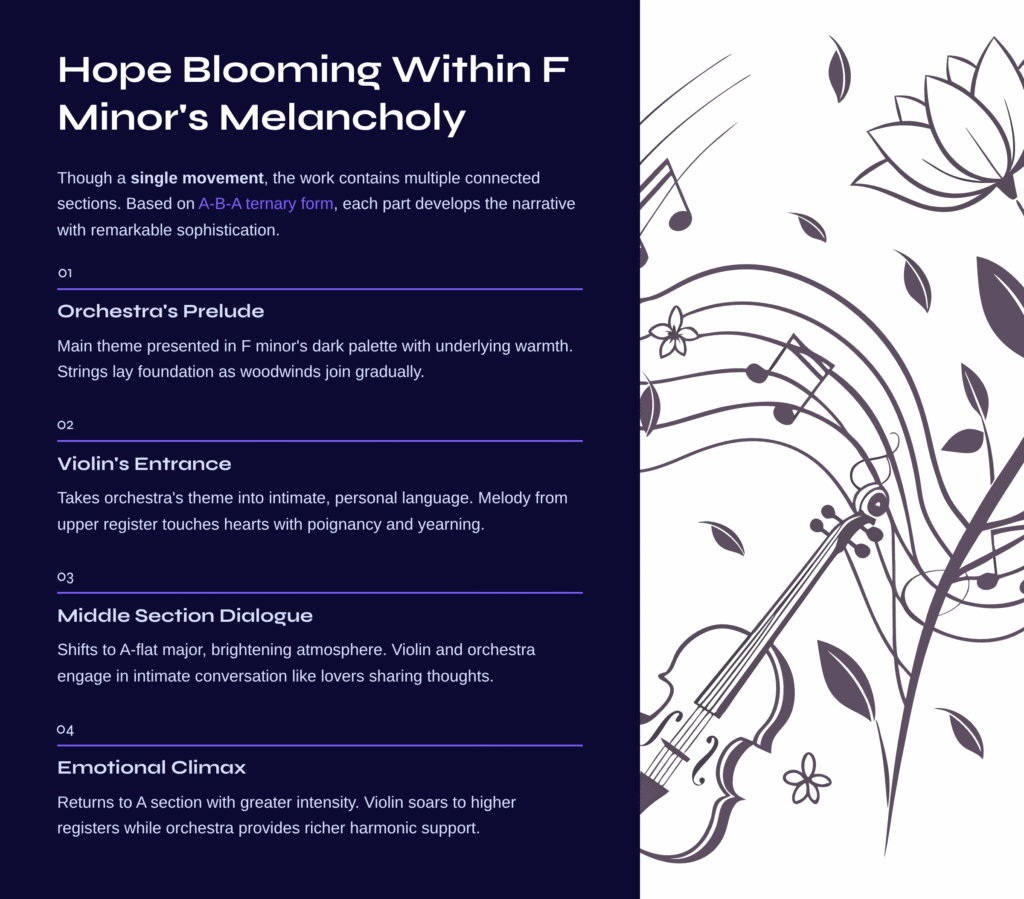
Hope Blooming Within F Minor’s Melancholy
Though structured as a single movement, the work contains multiple organically connected sections. Based on an A-B-A ternary form, each part engages in dialogue while developing the musical narrative with remarkable sophistication.
The Opening – Orchestra’s Prelude
The orchestra first presents the main theme. Even within F minor’s dark palette, there’s an underlying warmth in the melody. As the strings lay a gentle foundation, woodwinds gradually join one by one, like clouds slowly gathering in an evening sky.
The Violin’s Entrance – The Real Story Begins
Then the violin enters, taking the orchestra’s theme and translating it into more intimate, personal language. The melody flowing from the violin’s upper register touches our hearts with alternating waves of poignancy and yearning. Here, Dvořák chose to focus on pure lyricism over technical showmanship.
The Middle Section – Deepening Dialogue
The B section shifts to A-flat major, brightening the atmosphere considerably. This is where violin and orchestra engage in their most intimate conversation. Imagine two lovers sharing their deepest thoughts on a quiet park bench. The woodwinds’ warm responses blend with the violin’s melody, creating moments of pure enchantment.
The Recapitulation – Emotions Intensified
Returning to the A section, but now with far greater intensity and conviction. The violin soars to even higher registers, reaching the emotional climax while the orchestra provides richer harmonic support. Finally, it ends quietly, like a long, contemplative sigh trailing into silence.
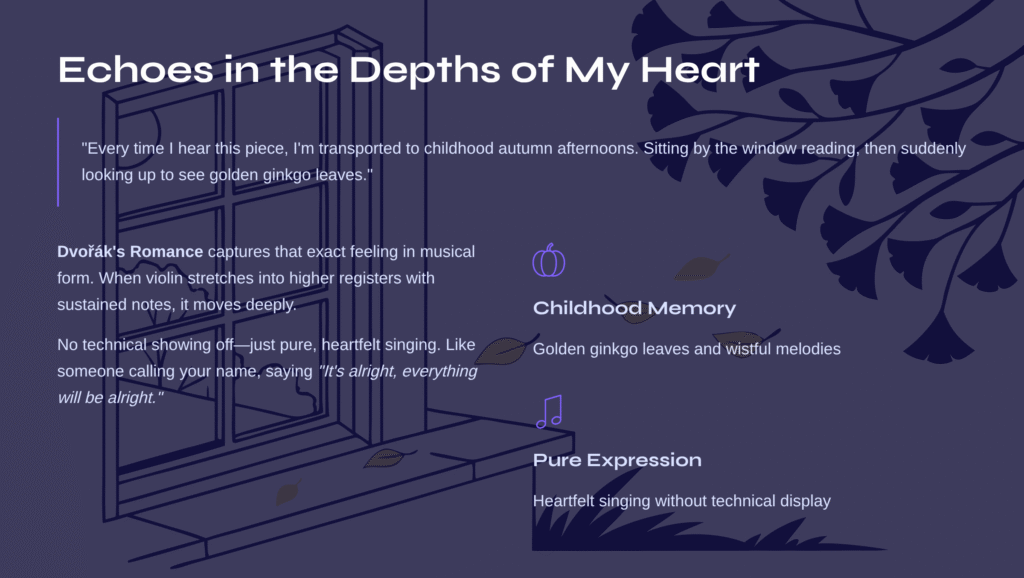
Echoes in the Depths of My Heart
Every time I hear this piece, I’m transported to childhood autumn afternoons. Sitting by the window reading, then suddenly looking up to see golden ginkgo leaves, with some wistful melody drifting from somewhere unknown. Dvořák’s Romance seems to capture exactly that feeling in musical form.
Those moments when the violin stretches into the higher registers with long, sustained notes particularly move me. No attempt at showing off technique—just pure, heartfelt singing. It’s as if someone is calling my name, saying “It’s alright, everything will be alright.”
The orchestra’s role is equally compelling. Neither overwhelming the violin nor merely providing accompaniment, it serves as a true musical partner, joining the violin in crafting one grand narrative.
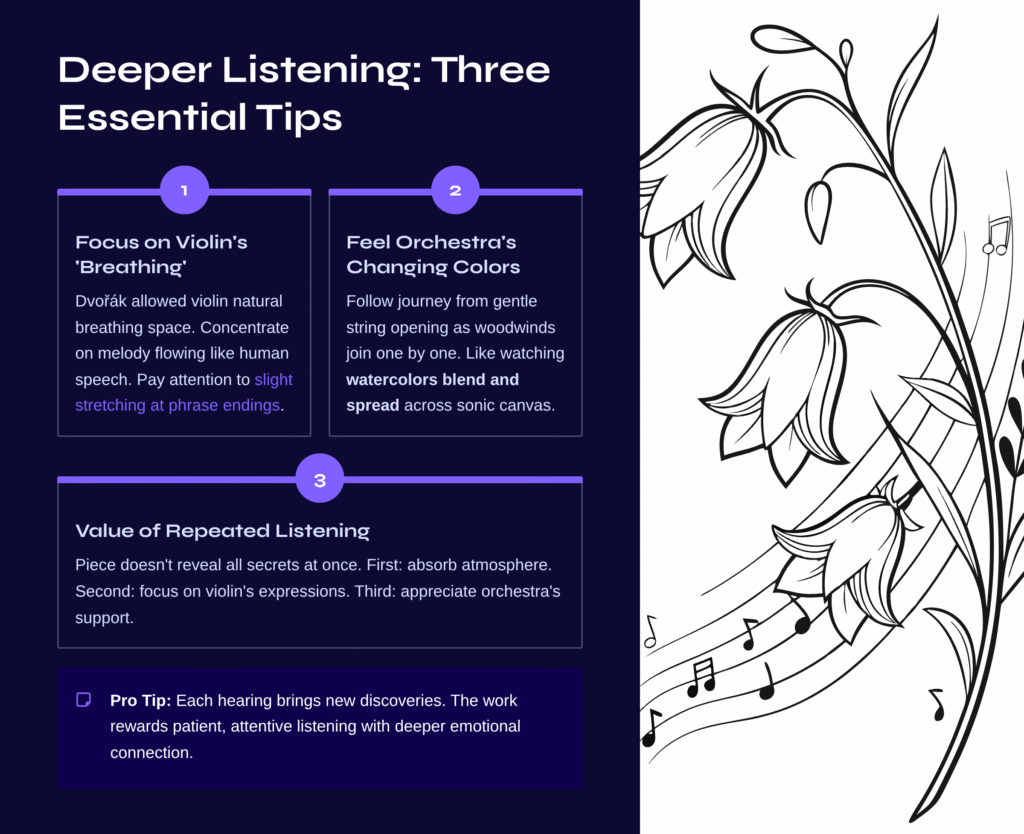
Deeper Listening: Three Essential Tips
First Tip – Focus on the Violin’s ‘Breathing’
Dvořák allowed the violin natural breathing space. Instead of forced virtuosity or flashy passages, concentrate on how the melody flows as naturally as human speech. Pay special attention to the slight stretching at phrase endings—this maximizes the work’s lyrical impact.
Second Tip – Feel the Orchestra’s Changing Colors
Follow the journey from the gentle string-dominated opening as woodwinds join one by one, enriching the tonal palette. Dvořák respected each instrument’s character while maintaining perfect ensemble balance. It’s like watching watercolors blend and spread across the sonic canvas.
Third Tip – The Value of Repeated Listening
This piece doesn’t reveal all its secrets at once. First listening: absorb the overall atmosphere. Second: focus on the violin’s subtle expressions. Third: appreciate the orchestra’s delicate support. Each hearing brings new discoveries.
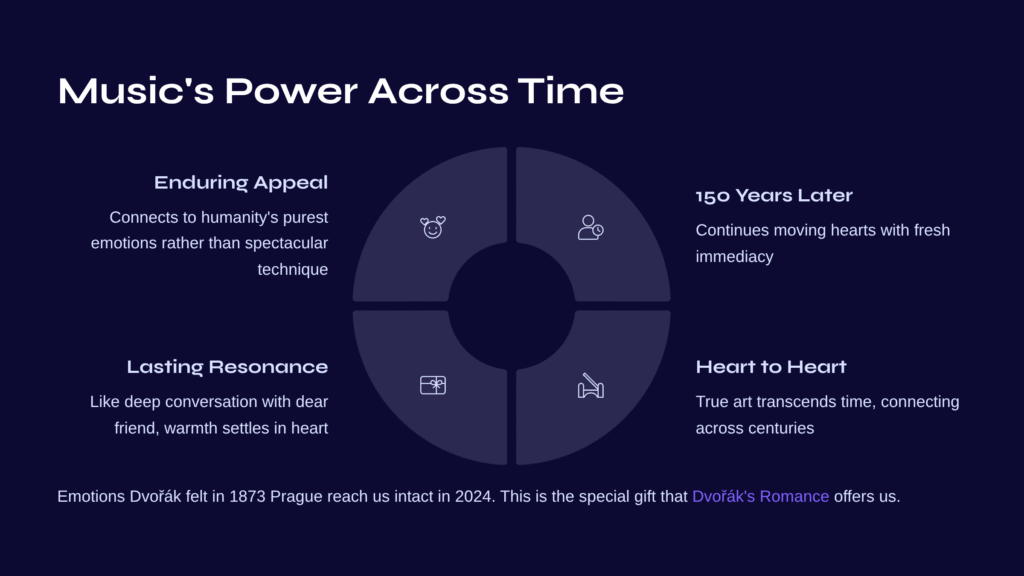
Music’s Power Across Time
Dvořák’s Romance in F minor continues to move hearts 150 years after its creation. Rather than relying on spectacular technique or complex structures, it appeals to humanity’s purest emotions. That’s its enduring power.
Listening to this work, I reflect on how true art transcends time by connecting heart to heart across the centuries. The emotions Dvořák felt in 1873 Prague reach us intact in 2024, as fresh and immediate as ever.
Long after the music ends, its resonance lingers. Like after a deep conversation with a dear friend, something warm settles in a corner of the heart. This is the special gift that Dvořák’s Romance offers us.
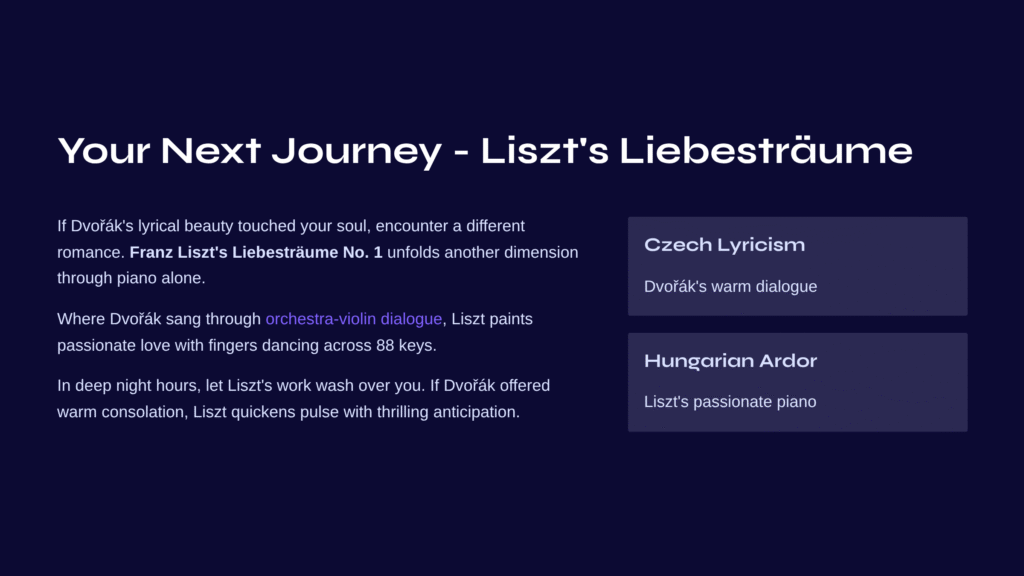
A Suggestion for Your Next Journey – Liszt’s Liebesträume
If Dvořák’s lyrical beauty has touched your soul, it’s time to encounter a different kind of romance. Franz Liszt’s Liebesträume No. 1 unfolds another dimension of romantic expression through the piano alone.
Where Dvořák sang of love through dialogue between orchestra and violin, Liszt paints more direct, passionate love with fingers dancing across 88 piano keys. Though both exemplify 19th-century Romanticism, comparing Czech lyricism with Hungarian ardor reveals fascinating contrasts.
In the deep hours of night, in your private space, let Liszt’s Liebesträume wash over you. If Dvořák’s Romance offered warm consolation, Liszt’s work will quicken your pulse with thrilling anticipation.
